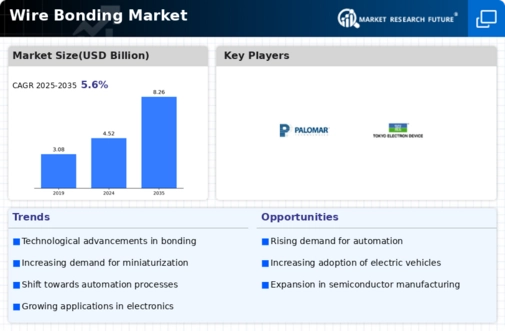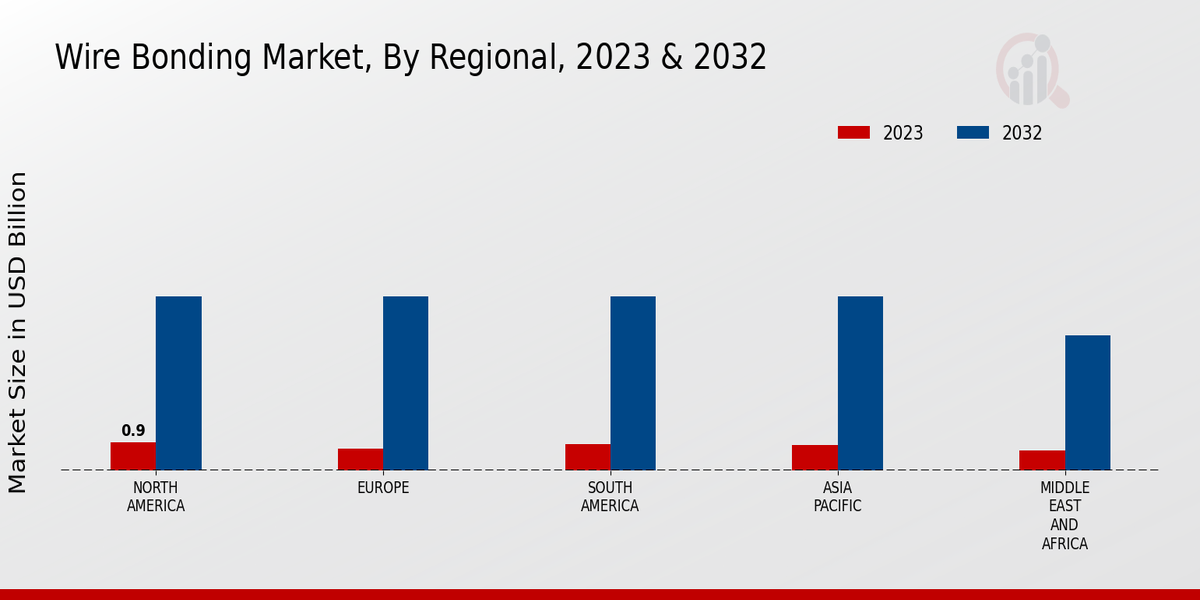Market Trends and Growth Projections
The Global Wire Bonding Market Industry is characterized by various trends that indicate its growth trajectory. Current projections suggest that the market will reach 4.52 USD Billion in 2024, with an anticipated increase to 8.26 USD Billion by 2035. The compound annual growth rate (CAGR) of 5.63% from 2025 to 2035 reflects the industry's resilience and adaptability to changing technological landscapes. Factors such as advancements in bonding techniques, increasing applications in diverse sectors, and the rising demand for efficient interconnection solutions contribute to this growth. These trends highlight the dynamic nature of the wire bonding market and its potential for future expansion.
Emerging Markets and Global Expansion
Emerging markets present significant opportunities for the Global Wire Bonding Market Industry. As countries in Asia-Pacific, Latin America, and Africa experience rapid industrialization and technological advancement, the demand for wire bonding solutions is expected to rise. These regions are witnessing an increase in electronics manufacturing, automotive production, and renewable energy projects, all of which require reliable wire bonding technologies. The market's growth in these areas could be substantial, with a projected CAGR of 5.63% from 2025 to 2035. This expansion may lead to increased competition and innovation within the industry, as companies strive to meet the diverse needs of these emerging markets.
Growing Demand for Consumer Electronics
The Global Wire Bonding Market Industry experiences a surge in demand driven by the increasing production of consumer electronics. As devices such as smartphones, tablets, and wearables become ubiquitous, manufacturers require efficient and reliable interconnection solutions. Wire bonding technology, known for its cost-effectiveness and reliability, plays a crucial role in ensuring the performance of these devices. In 2024, the market is projected to reach 4.52 USD Billion, reflecting the industry's response to the escalating consumer electronics market. This trend is expected to continue, with the market potentially expanding as consumer preferences evolve towards more advanced electronic features.
Advancements in Semiconductor Technology
Technological advancements in semiconductor manufacturing significantly influence the Global Wire Bonding Market Industry. Innovations such as miniaturization and the development of new materials enhance the performance and efficiency of wire bonding processes. As semiconductor devices become smaller and more complex, the demand for precise and reliable bonding techniques increases. This evolution is likely to drive market growth, with projections indicating a market size of 8.26 USD Billion by 2035. The integration of advanced wire bonding technologies in semiconductor applications could lead to improved device performance and reliability, further solidifying the industry's position in the global market.
Rising Demand for Renewable Energy Solutions
The Global Wire Bonding Market Industry is positively impacted by the growing demand for renewable energy solutions. As the world shifts towards sustainable energy sources, the need for efficient interconnection technologies in solar panels and wind turbines becomes paramount. Wire bonding technology is essential in ensuring the reliability and efficiency of these renewable energy systems. The increasing investments in renewable energy infrastructure are likely to bolster the market, as manufacturers seek reliable bonding solutions to enhance energy conversion efficiency. This trend aligns with global sustainability goals, potentially leading to a more robust market presence for wire bonding technologies.
Increasing Automotive Electronics Integration
The integration of electronics in the automotive sector is a pivotal driver for the Global Wire Bonding Market Industry. With the rise of electric vehicles and advanced driver-assistance systems, the demand for reliable wire bonding solutions is on the rise. Automotive manufacturers are increasingly adopting wire bonding technology to ensure robust connections in critical electronic components. This trend is expected to contribute to the market's growth, as automotive electronics are projected to expand significantly in the coming years. The industry's adaptation to meet automotive standards may enhance its overall market presence and drive innovation in wire bonding techniques.




